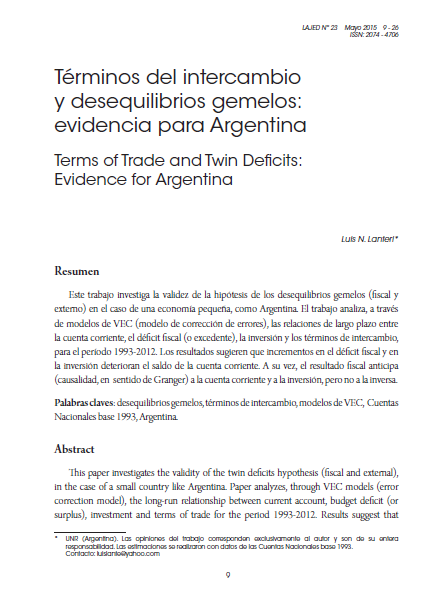Terms of Trade and Twin Deficits: Evidence for Argentina
DOI:
https://doi.org/10.35319/lajed.20152374Keywords:
twin deficits, terms of trade, VEC models, National Account base 1993, ArgentinaAbstract
This paper investigates the validity of the twin deficits hypothesis (fiscal and external), in the case of a small country like Argentina. Paper analyzes, through VEC models (error correction model), the long-run relationship between current account, budget deficit (or surplus), investment and terms of trade for the period 1993-2012. Results suggest that increases in the fiscal deficit and investment deteriorate current account balance. Moreover, fiscal balance anticipate (Granger causality) to the current account and investment, but not the reverse.
Downloads
References
Altintas, Halil y Taban, Sami (2011). “Twin Deficits Problem and Feldstein-Horioka Hypothesis in Turkey: ARDL Boung Testing Approach and Investigation of Causality”. International Research Journal of Finance and Economics, (74), 30-45.
Bagheri, Farzane; Keshtkaran, Salma y Hazrati, Fatemeh (2012). “Twin Deficits and Feldstein-Horioka Puzzle in the case Iran”. Journal of Social and Development Sciences, (5), 167-71.
Barro, Robert (1974). “Are Government Bonds Net Wealth?”. Journal of Political Economy, (82), 1095-1117.
---------- (1989). “The Ricardian Approach to Budget Deficits”. Journal of Economic Perspectives, (3), 37-52.
Cortés Conde, Roberto (2013). “El descontrol del gasto público jaquea a la democracia”. La Nación, 17 de septiembre (http://www.lanacion.com.ar/1620506-8000-car-od-et-ullaore-rostin-ut-ashdhas-asdel-descontrol-del-gasto-jaquea-a-la-democracia).
Damill, Mario; Frenkel, Roberto y Juvenal, Luciana (2003). “Las cuentas públicas y la crisis de la convertibilidad en la Argentina”. Documento de trabajo. CEDES. Buenos Aires. 1-43.
Edwards, Sebastian (2001). “Does the Current Account Matter?”. National Bureau of Economic Research (NBER). Working Paper N° 8275.
Feldstein, Martin y Horioka, Charles (1980). “Domestic Savings and International Capital Flows”. The Economic Journal, (90), 314-29.
Fountas, Stilianos y Tsoukis, Chistopher (2000). “Twin Deficits, Real Interest Rates and International Capital Mobility”. National University of Ireland (Galway). Working Paper N° 49.
Johansen, Soren (1988). “Statistical Analysis of Cointegration Vectors”. Journal of Economic Dynamics and Control, (12), 231-54.
Johansen, Soren y Juselius, Katarina (1990). “Maximum Likelihood Estimation and Inference on Cointegration-with Application to the Demand for Money”. Oxford Bulletin of Economics and Statistics, (52), 169-210.
Keifman, Saul (2004). “Auge y derrumbe de la convertibilidad argentina: lecciones para Ecuador”. Iconos, N° 19. FLACSO. Quito, Ecuador, 25-34.
Kouassi, Eugene; Mougoue, Mbodja y Kymn, Kern (2004). “Causality Tests of the Relationship between the Twin Deficits”. Empirical Economics, (29), 503-25.
Lütkepohl, Helmut (1991). “Introduction to Multiple Time Series Analysis”. Springer Verlag, Berlin.
Marinheiro, Carlos (2008). “Ricardian Equivalence, Twin Deficits and the Feldstein-Horioka Puzzle in Egypt”. Journal of Policy Modeling, (30), 1041-56.
Megarbane, P. (2002). “Slovakia’s External Current Account Deficit: Why so large and is it Sustainable?”. Country Report 210. IMF. Washington, DC.
Mohammadi, Hassan y Moshrefi, Golaleh (2012). “Fiscal Policy and the Current Account new evidence from four East Asian Countries”. Applied Economics Letters, (19), 167-173.
Nickel, Christiane y Vansteenkiste, Isabel (2008). “Fiscal Policies, the Current Account and Ricardian Equivalence”. European Central Bank. Working Paper Series N° 935. Septiembre.
Obstfeld, Maurice y Rogoff, Kenneth (1995). “The Intertemporal Approach to the Current Account”. En: G. Grossman y K. Rogoff (eds.), Handbook of International Economics, vol. III. Amsterdam. Elsevier, 1731-99.
---------- (1996). “The Six Major Puzzles in International Macroeconomics: is there a Common Cause?”. Working Paper N° 7777. NBER, Cambridge.
Sachs, Jeffrey (1981). “The Current Account and Macroeconomic Adjustment in the 1970s”. Brookings Papers on Economic Activity. 1. 201-282.
Xuan Lam, Nguyen (2012). “Twin Deficits Hypothesis and Feldstein-Horioka Puzzle in Vietnam”. International Research Journal of Finance and Economics, (101), 169-178.






